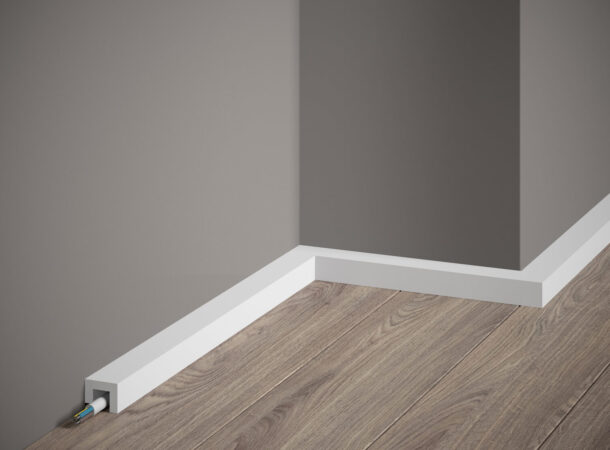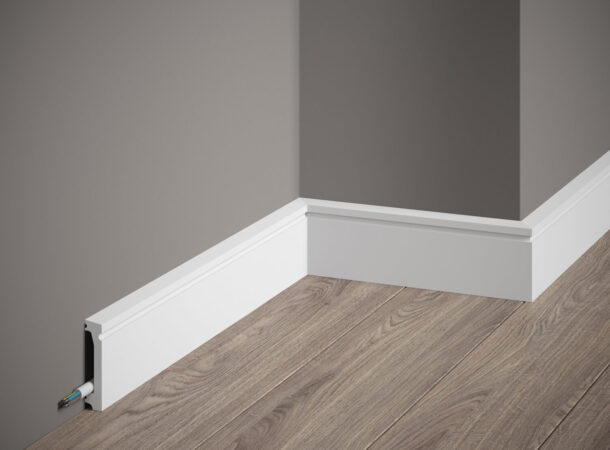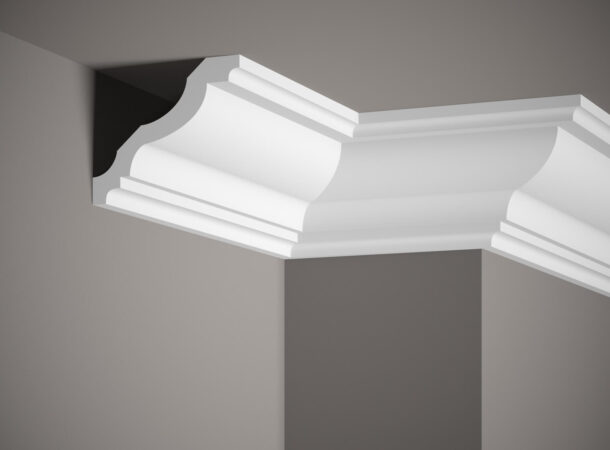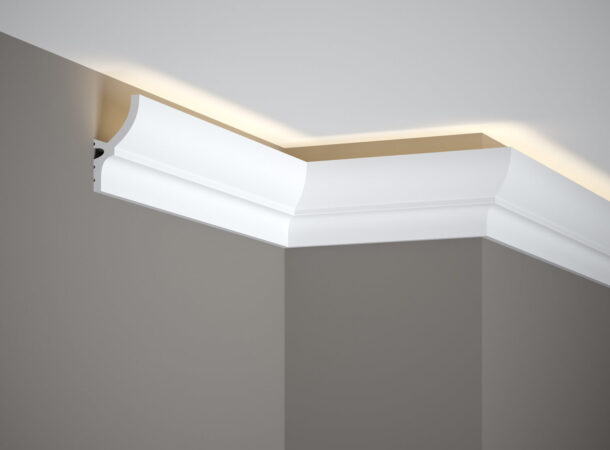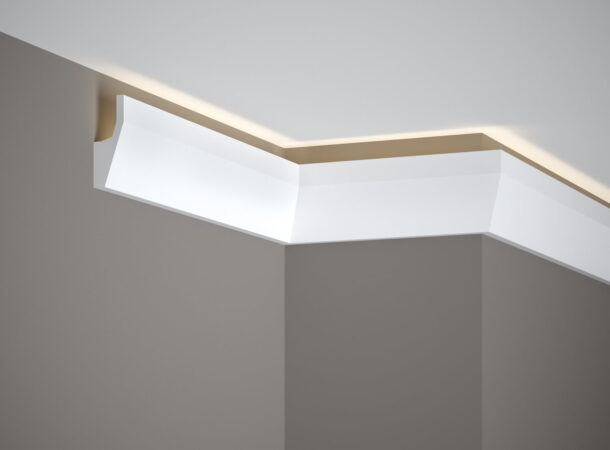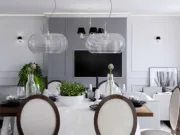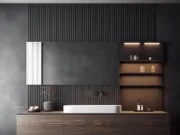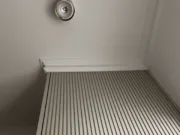Modern stucco in a minimalist interior – how to integrate decorative strips
The contemporary approach to interior design is increasingly leaning towards minimalism, which is the choice of many people raised in the 1990s. Cluttered and cramped rooms, full of large furniture in warm tones and a mixture of colors and patterns – from books, through figurines, to plastic tazos – gave rise to the need to create comfortable, subdued spaces with a minimum of things “out there”. Although minimalist in concept, interiors in this style are definitely not boring and there is definitely room for colors and accessories, including stucco. How to combine it so that it looks stylish, but at the same time does not take away our sense of space? Is modern stucco in a minimalist interior a good choice?

Without unnecessary building of suspense – of course yes 🙂 Minimalist interiors, although limited in concept to simple forms and a subdued color palette, definitely do not have to be boring. There is space for colors, modern decorative elements, as well as strips that add class and style. In order for the interior stucco to be a coherent decorative element in a minimalist interior, it must be skillfully incorporated.
Wall stucco as a subtle decoration in a minimalist room
The minimalist style, based on the principle “less is more”, is characterized by an emphasis on neutral shades such as gray, white and beige. It is also characterized by orderly space, straight lines and geometry in the furniture, which together create a coherent and orderly interior. However, minimalism does not mean giving up decorations. On the contrary, properly selected colors, patterns, accessories and wall moldings can add depth and character to the interior, emphasizing its unique style, without disturbing the sense of space and order.

Minimalist interiors, despite their basic form, do not have to be devoid of character. Such spaces can be complemented by strong, contrasting accents that will attract the eye and add character to the arrangement. It can be a distinctive color on one of the walls, an original photo wallpaper, or elegant, modern stucco, which, thanks to its subtlety, will become not only a decoration, but also a distinct, although not dominant, element of the interior. Accessories such as finishing strips can significantly influence the final appearance of the room, adding that “something” to the arrangement.
Minimalist interiors often draw on the love of Scandinavian style, which emphasizes simplicity, subdued colors, thoughtful accessories and high functionality. When choosing stucco, it is worth paying attention to the quality of the materials used. Not so long ago, polystyrene strips were popular, appreciated for their low price and ease of installation. However, their poor durability and high susceptibility to mechanical damage mean that more and more people are looking for more durable solutions. Polyurethane products are a much more durable option. Mardom Decor polyurethane stucco is a modern solution, manufactured from a proprietary mixture of high-quality polymers with refiners. The proprietary PolyForce material, just like Styrofoam stucco, is highly resistant to the harmful effects of water, and the high density of the material provides much better resistance to mechanical damage.
Ceiling and floor moldings
Floor stucco is a must-have in almost every interior because it fulfills not only aesthetic but also practical functions. It is useful for masking expansion spaces between the floor and the wall, protecting the edges of the floor from damage and preventing dust from accumulating in hard-to-reach places. Another issue is protecting the walls against dirt and impacts, especially in the corners. Moreover, the properly matched shape of the floor stucco adds elegance and properly finishes the room, emphasizing its style. The ScratchShield® Mardom Decor technology used in all floor strips additionally increases the functionality of the stucco, offering high protection against mechanical damage. Thanks to the use of special polymer hardeners, products equipped with ScratchShield® are characterized by increased resistance to scratches, dents and other damage that may occur during everyday use.
Ceiling strips are often treated only as decorative strips, but they can also have practical applications in minimalist interiors. These internal stucco elements are ideal as a solution to hide the empty space between the cabinets and the ceiling, especially in kitchens, where maintaining aesthetic continuity is crucial. Thanks to the use of ceiling strips not only on the wall, but also as an element of furniture, the interior gains a uniform and coherent appearance, which is especially important in arrangements focused on minimalism and simplicity. Ceiling strips, thanks to their universality, can also be used to mask curtain rods, which allows for trouble-free installation of stucco around the entire perimeter of the room, maintaining a consistent visual effect.
Ceiling strips are also used in modern lighting solutions, such as LED stucco. Lighting strips, dedicated to use with LED strips, are a practical solution that allows you to discreetly hide unsightly-looking LED strips. Additional elements are masked and unified, and the need to install an additional chandelier or wall lamp is minimized. However, not all decorative strips will be suitable for this purpose, it is worth choosing dedicated ceiling stucco. LightGuard® Mardom Decor technology guarantees even light dispersion, eliminating the effect of spot LED penetration. Thanks to this, decorative strips become not only a decorative element, but also a functional one, enriching the arrangement with a new aesthetic dimension.
When deciding to introduce stucco elements into the interior, it is important to consider what effect we want to achieve. Minimalism prefers simple lines and geometric shapes, so uncomplicated, simple forms will be perfect for lovers of this style. However, this is not always the desired effect – sometimes it is worth opting for slightly more decorative options, such as milled strips, although too richly decorated profiles should be avoided, which could overwhelm a minimalist interior. The visual “weight” of the product is also important – dark colors and rich decorations may seem heavier than simple forms in light shades. Mardom Decor stucco is covered with a high-quality, matte primer, which is an excellent base for painting. The strips can be easily repainted in any color with water-based wall paint, which allows for full adaptation to individual needs and arrangement preferences.
Interior wall stucco

Wall stucco can also be successfully used in minimalist spaces. Choosing minimalist models with small dimensions will allow you to create a decoration that is elegant, but still consistent with the chosen style of the room. Alternatively, you can also use decorative wall or lamella panels on one of the walls, adding some three-dimensionality to the interior. Spatial wall decoration introduces an interesting element into the interior, without overwhelming it. Just like Mardom Decor wall stucco – the panels and white slats can be painted to match the wall color (a subtle effect) or, on the contrary, add a color accent (a much more expressive decoration), further emphasizing their decorative role in the interior. It is important to choose one main color so as not to accidentally turn a harmonious arrangement into artistic chaos.
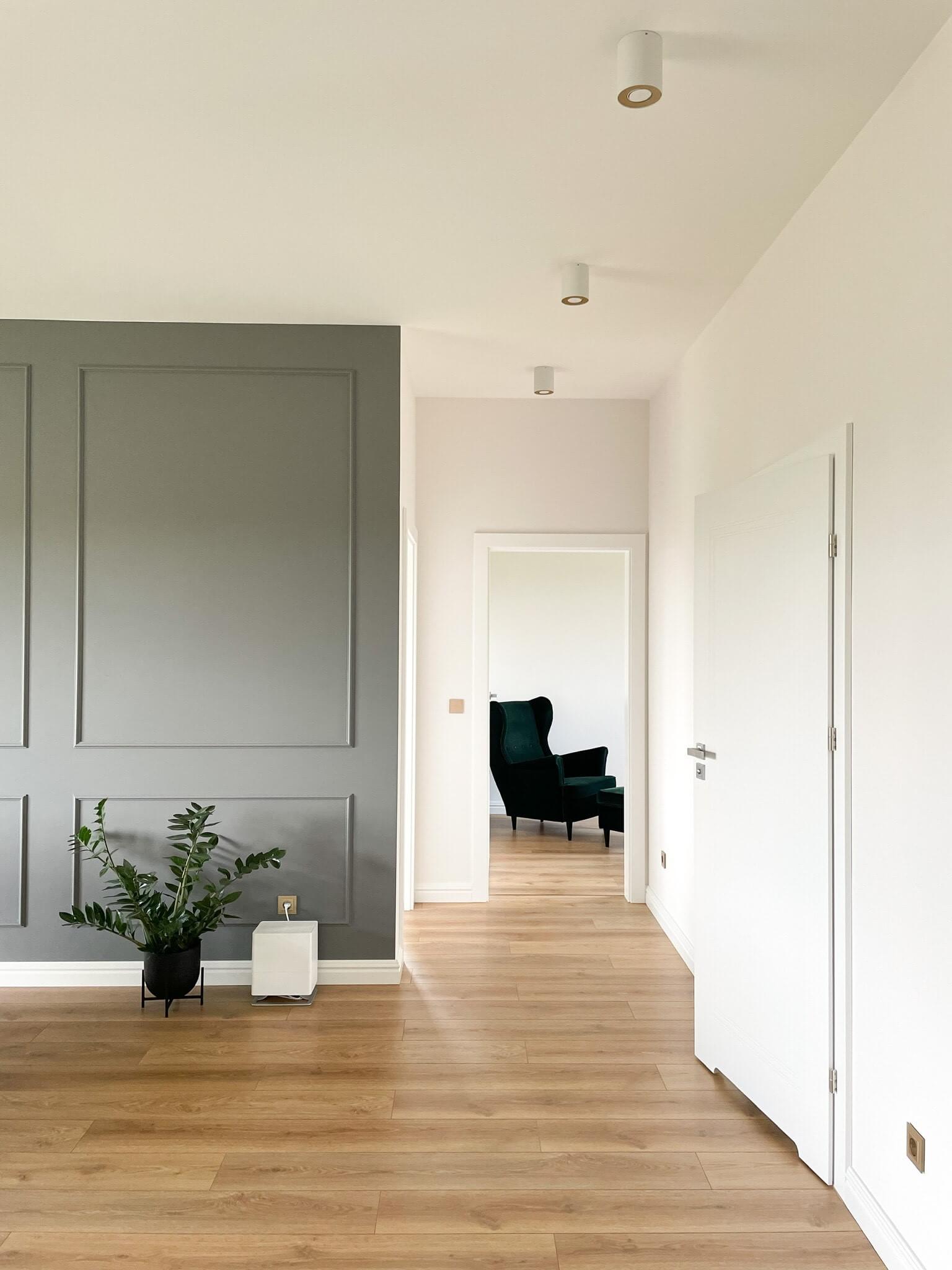
A perfect example of using wall stucco in a minimalist space is the arrangement by @domprzyulicypolnej. The spacious interior, where the main decoration are MD413 Mardom Decor wall strips, captivates with its simplicity and elegance. The strips installed in three rows create attractive and simple frames that perfectly fill a flat space, giving it three-dimensionality. The use of MD413 wall strips in this arrangement, covered with a dark shade identical to the color of the wall, turned out to be a bull’s-eye, emphasizing the elegance and luxury of the interior, while maintaining a minimalist form. The use of ScratchShield® technology guarantees high durability and scratch resistance, which makes Mardom Decor interior stucco an ideal solution for anyone looking for a way to incorporate decorative strips into a minimalist and functional interior.
Practical arrangement tips – how to achieve the perfect balance in a minimalist interior with stucco walls
Modern stucco can successfully complement minimalist design, adding class and elegance to it. When choosing stucco, it is crucial to pay attention to its dimensions – both height and width are important. Width seems to be an obvious parameter, especially in the case of floor stucco that must cover the expansion joint. But what’s the deal with her height? Tall moldings in a small room will make it even smaller, and those with small dimensions in a large, spacious house will completely disappear and look caricatured. In the case of wall imperfections, properly selected strips can effectively mask them, while adding elegance to the interior. In rooms with different heights, strips with a width of 7 cm for interiors up to 260 cm, 12 cm for standard heights of 270-280 cm and 15 cm in spaces above 280 cm are recommended. Such matching will allow you to achieve harmony and avoid the impression that decorative elements will be overwhelmed or disappear in the space.
An additional functionality worth paying attention to when choosing stucco in interior design is the ability to hide cables and wires. This is especially important in minimalist interiors, where reducing unnecessary elements to a minimum is key. Stucco offering special spaces for cables not only improves aesthetics, but also increases safety of use.
When deciding on the use of stucco, it is very important to use decorative elements wisely. A minimalist interior will gain character thanks to the conscious use of strips that can both attract the eye and blend harmoniously with the rest of the arrangement. Here are some aspects worth paying attention to:
- If you’re still wondering if stucco wall is the right choice, start by using it on a smaller wall. A small wall is a more subtle effect that will help you gauge whether this is the direction you want to go.
- In the case of larger walls, stucco can create a significant decorative effect, emphasizing the character and atmosphere of the room. This is a great way to highlight important parts of the interior, e.g. the dining area, as seen in the @domprzyulicypolnej house.
- Combining stucco frames with a contrasting, darker color, such as the increasingly used black, on opposite sides of the walls can visually make the room smaller. This technique is particularly useful to correct the proportions of a long room, but it must be used consciously. Dark walls with decorations will seem closer to each other, if we use them on a longer surface, we will narrow the space even more, obtaining the effect of a tram.
- The use of stucco in a uniform wall color allows you to discreetly mask the door, creating a uniform, coherent wall surface. This is an ideal solution for non-rebated doors, where decorative strips are installed across the entire width of the wall (and door surface), creating a uniform pattern.
In minimalist arrangements, where straight lines are valued, it is recommended to choose straight joints instead of decorative corners. The ends of the strips should be cut at an angle of 45 degrees to ensure an aesthetic finish of the corners. For PolyForce Mardom Decor stucco, all you need is a universal, high-quality glue such as Fix Pro. It is worth paying attention to this in the case of other stucco brands in order to achieve a stable and durable attachment to the wall (e.g. in the case of joining NMC stucco elements, dedicated glue).

